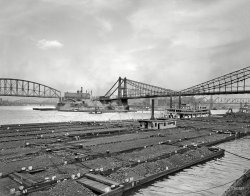
MAY CONTAIN NUTS

Search Shorpy
SHORPY ART

Framed or unframed, desk size to sofa size, printed by us in Arizona and Alabama since 2007. Explore now.
Join and Share
Ad-Free Shorpy
Shorpy is funded by you. Patreon contributors get an ad-free experience.
Learn more.

Recent comments
- Good choice
- Recent view
- Hudson’s Big Store
- Say what??
- Grapes?!
- A Beautiful Moment
- Such joy
- Bethune-Cookman University today...
- Yellow sky at morning
- Side Winder
- Air Quality?
- Sojourner Truth riot
- None were so blind(ed)
- The less famous sister
- Good ol' days?
- Rise and Fall
- Goo Goo Ga Joob
- Ticket Retention
- Not the only one
- Vagaries of War
- Killed by Amtrak
- Back to the Future
- Wanted --
- If you can't stand the light
- Centralized Traffic Control, I believe
- What's really happening
- Heckuva remote control!
- Sometimes — Things Go Bump!
- I SEE THE LIGHT
- Union Switch and Signal Company
Member Photos
The Shorpy
Print Emporium
Print Emporium
Search Shorpy
Search results -- 30 results per page
- The Nixon: 1908
- Pittsburgh, Pennsylvania, circa 1908. "Nixon Theatre, Sixth Avenue & Cherry ... a carriage call . - tterrace]
(The Gallery, DPC, Pittsburgh, Streetcars) ... Posted by Dave - 07/24/2012 - 11:40pm -
![The Nixon: 1908 Pittsburgh, Pennsylvania, circa 1908. "Nixon Theatre, Sixth Avenue & Cherry Alley." 8x10 inch glass negative, Detroit Publishing Company. View full size.
+108Below is the same view from July of 2016.
Digital Street Clock?Under the Nixon sign and at the street curb, on the pole. It appears to be a three character dot matrix display.
This is the second such display I've seen in a Shorpy photo. I've Googled several phrases but can't find anything like it. Anybody?
Sam, Fred, SamThe Nixon-Nirdlinger family owned and ran the Nixon Theatre. Sam Nixon passed away in 1918, and the business passed to his son Fred. Fred had a remarkable ability to keep wedding cake companies in business - marrying five different women, the fifth one twice. Fifth wife Charlotte Nixon-Nirdlinger shot and killed Fred on the French Riviera in 1931, and was eventually acquitted on the grounds of self-defense. In 1931, Sam's grandson Sam took over the theatre. It was demolished in 1950, for a new Alcoa building.
Torn down in 1950The Nixon stood till 1950 when it was torn down to make room for the (ugly) former Alcoa HQ.
http://www.post-gazette.com/pg/10122/1054577-426.stm
Digital DisplayGood observation, jdowling. I have no idea what it was used for, but a digital number display is exactly what it is. The seemingly random arrangement of the "pixels" is so that the digits are nicely formed. I can just barely remember the change (in the Fifties) of the scoreboard at the high-school football stadium from one like that to the newer "7-segment" concept.
The originals, like the one here, were an electric nightmare (calling them "electronic" was decades in the future) requiring incredible amounts of wiring, switches, and relays, and broke down very often. Perhaps that's why this one isn't lit.
[We've since learned it's a carriage call. - tterrace]
(The Gallery, DPC, Pittsburgh, Streetcars)](https://www.shorpy.com/files/images/SHORPY_4a22931a.thumbnail.jpg)
- Pennsylvania Lines: 1900
- ... docks, Erie, Pennsylvania." Also represented: Cars of the Pittsburgh, Fort Wayne & Chicago Railway. 8x10 inch glass negative, Detroit ... my understanding:
The PRR, particularly west of Pittsburgh, consolidated a large number of existing railroads. The Pittsburgh, ... Posted by Dave - 07/19/2016 - 3:07pm -
![Pennsylvania Lines: 1900 Circa 1900. "Anchor Line docks and Penna. R.R. coal & ore docks, Erie, Pennsylvania." Also represented: Cars of the Pittsburgh, Fort Wayne & Chicago Railway. 8x10 inch glass negative, Detroit Publishing Co. View full size.
Women's dresses are ShortThose dresses only go down to the women's knees. Awfully short based on what I have seen for other women's attire for that time period.
[An indication they're children. -tterrace]
Women near the tracks.One thing that children and women did near the tracks in the days of coal burning locomotives was to scavenge lumps of coal that fell from the tenders as the engines passed. Train crews sometimes accidentally caused coal to fall off to help the folks who needed heat in their houses near the tracks, so those bags might just be full of coal!
Someone please tell mewhat are those two women doing by the tracks?
A little PRR Corporate and Lettering HistoryHere's my understanding:
The PRR, particularly west of Pittsburgh, consolidated a large number of existing railroads. The Pittsburgh, Fort Wayne & Chicago (P FW & C) was the railroad that swallowed up the others. Then, the PRR reorganized into 2 activities, the "Pennsylvania Company" owned and operated railroads east of Pittsburgh, and "Pennsylvania Lines" operated lines west of Pittsburgh.
In the front left to right, we see an earlier 19th century boxcar for the eastern part of the railroad and then two cars lettered in the turn-of-the-century style for the 'lines west' Then there is a Fast Freight Line car for the Union Line, which at one time was an association of railroads to provide through freight (same car across multiple railroads.) By this time, though, the Union Line was pretty much a marketing activity of the Pennsylvania company. Finally on the right, a P FW & C car with the earlier lettering. This also provides a great assortment of PRR 'standard cars' The car on the far right has the Wagner Door, an early tight sealing/plug arrangement (where the door slides out and then to the left. This website has a lot of information on the PRR cars, see in particular the PRR XB, XC and XD cars, which are all represented in the photo.
http://prr.railfan.net/freight/
Two womenI saw them, too. Looking closer, they have some bundles of something, so I was wondering if they brought lunch for their husbands and are setting up a little picnic. A lot of the men seem to be standing around, such as near the railing on that loader thing. I also noticed that middle frame is a big steam flume going up, which made me wonder if that was a noontime whistle signaling lunchtime, and the cameraman was waiting for just that moment to snap the shot. Hard to say what's going on.
[Looks more like laundry, perhaps. -tterrace]
(The Gallery, Boats & Bridges, DPC, Mining, Railroads)](https://www.shorpy.com/files/images/SHORPY-4a08392a4a.thumbnail.jpg)
- National Tube Works: 1910
- Pittsburgh, Pennsylvania, circa 1910. "Furnaces, National Tube Works." 8x10 ... the NYC amalgamation.
(The Gallery, DPC, Factories, Pittsburgh, Railroads) ... Posted by Dave - 07/29/2012 - 1:32pm -
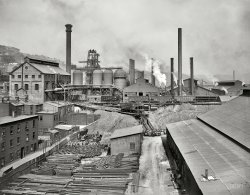
- Smithfield Street: 1908
- Pittsburgh, Pennsylvania, circa 1908. "Smithfield Street and the Post Office." ... July of 2016.
(The Gallery, Cars, Trucks, Buses, DPC, Pittsburgh) ... Posted by Dave - 08/15/2012 - 4:16pm -
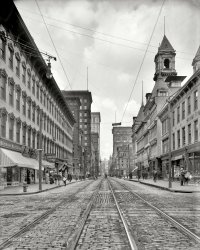
- Happy Motoring: 1942
- ... Fort Pitt Ale. Fort Pitt Brewing Company, Sharpsburg and Pittsburgh, PA(1906 - 1957). Perhaps the best selling beer in the Pittsburgh area at one time and Romney was certainly within the marketing area ... Posted by Dave - 08/03/2008 - 12:50am -
![Happy Motoring: 1942 1942. "Cemetery at edge of Romney, West Virginia." View full size. 35mm Kodachrome transparency by John Vachon for the Office of War Information.
The Gaunt Brooding StateIn the book "John Vachon's America" (University of California Press), there are numerous letters written by him to his wife while he was on the road for the Farm Security Administration. In an entry dated January 24, 1942, he writes:
Romney, West Va. First day out. Night now, and many Saturday night people on the main street of this little town of dark West Virginia. The gaunt brooding state of the U.S. The West Virginia people have lean angular faces with dark seamed wrinkles. The bony women have thin breasts and strange sweet straight lips. Black Sunday suits on the men with combed hair, and shapeless color printed dresses on the women.
Country RoadsWest Virginia, mountain mama
Take me home, country roads.
At first glance, I thought this was another of tterrace's slides. Surprise, it's by John Vachon. For photo historians, it must be nice to have the year prominently displayed on a billboard!
Fort Pitt AleGorgeous! What a lovely photo. Can anyone read the brand of ale in the billboard on the right? "Fort Pitt?"
["A toast to the holidays. Fort Pitt Ale." - Dave]
Dead Man's CurveThe road is Interstate 50, and the cemetery is Indian Mound.
Could have been yesterday.Aside from the car and the billboard, it almost seems as if this photo could have been taken yesterday. There are many areas which still look exactly like this.
Indian MoundThat'd be US 50, not Interstate 50.
Fort Pitt Ale"A toast to the holidays" Fort Pitt Ale. Fort Pitt Brewing Company, Sharpsburg and Pittsburgh, PA(1906 - 1957). Perhaps the best selling beer in the Pittsburgh area at one time and Romney was certainly within the marketing area of the brewery. It vaguely looks like the woman on the billboard is wearing a ski outfit, but at that time skiing was far from the popular sport it is today. Curiously, this sign may have explained the origin of a colloquialism known to many from Pennsylvania, "That's it, Fort Pitt" or the reverse, "Fort Pitt, That's It" was an advertising slogan for Fort Pitt Brewery. See: http://www.flickr.com/photos/13ball/2334579584/
Also, I would note that there is no Interstate 50, but certainly a US 50.
Local breweriesLike Fort Pitt, there were a lot of breweries in the area of Allegheny County. Most of the buildings are still standing. Some still have that ascetic appeal of the early architecture of years ago.
(The Gallery, Cars, Trucks, Buses, John Vachon)](https://www.shorpy.com/files/images/1a34276u.thumbnail.jpg)
- Flag Day: 1941
- June 1941. "Flag Day. Pittsburgh, Pennsylvania." Medium format acetate negative by John Vachon for ...
(The Gallery, Factories, John Vachon, Patriotic, Pittsburgh) ... Posted by Dave - 09/04/2020 - 3:36pm -
![Flag Day: 1941 June 1941. "Flag Day. Pittsburgh, Pennsylvania." Medium format acetate negative by John Vachon for the Farm Security Administration. View full size.
Paraphrasing Justice Potter StewartI shall not attempt further to define a great photograph ... but I know one when I see one.
This is a great photo.
Flag questionShouldn't the stars on the flag from 1941 be in a 6x8 grid, not offset rows as shown in the photo?
[The 1912 executive order pertaining to 48-star flags specifies only that the stars be in six rows of eight stars each, "symmetrically arranged." And of course the flag makers could arrange the stars however they wanted. There are (or were) countless examples of flags with stars both staggered and gridded. - Dave]
KudosJohn Vachon was a great talent. What an incredible picture!
Timeless window screenI am reminded of all the places I've lived where I had one of those screens to insert in the window opening. They're still around. Would keep out the flies, but wouldn't be effective against the smoke from those mills.
Fly the flag!And step out for a breath of fresh air.
Flag --Looks like the US flag for 1890-1891 - 43 stars. Probably flew what he had.
[This flag has 48 stars. - Dave]
(The Gallery, Factories, John Vachon, Patriotic, Pittsburgh)](https://www.shorpy.com/files/images/SHORPY-8c19359a.thumbnail.jpg)
- Greatest Show on Earth: 1904
- ...
Lincoln > Chatham > Mayfair From the historic Pittsburgh Images site, it appears that this hotel eventually became the Hotel ... This would be a great one to color.
(The Gallery, DPC, Pittsburgh) ... Posted by Dave - 08/14/2012 - 8:48pm -
![Greatest Show on Earth: 1904 1904. "Hotel Lincoln, Pittsburg." Let's turn our attention to those Barnum & Bailey circus posters: "Two days only, commencing Wednesday afternoon May 18, Old Stock Yard Grounds, East Liberty. Two performances daily, doors open at 1 and 7 p.m." Featured act: The Wentworth Trio, "trick riders in a series of entirely new equestrian acts with running horses and English road carts." 8x10 inch dry plate glass negative, Detroit Publishing Company. View full size.
Penn and FifthThe old city directories show the Hotel Lincoln at Penn Avenue and Fifth Street. ("Rooms without bath, $1.50 single, $2 double; with bath, $2 single, $3 double.") Sometime around 1910 the name was changed to Hotel Chatham. Seems to have been demolished around 1960.
Its corner of Penn and Fifth is now occupied by Fifth Avenue Place.
Nightmare fuelThose creepy clown faces make me glad the other poster is cut off. Even the guy at the top of the poster has a creepy expression.
Moreover, the guy in the hotel window has a sort of eeriness all his own. He looks like a statue.
106 years laterWaiter in dining room finally gets his 15 minutes of fame!
Creepiest Show On EarthFact: In 1904 there were still no limits as to how scary your clowns could be.
Inside and OutIf you open the image to full size - it is interesting to see one well dressed man in the window of the hotel and then one not so well in the alley of the hotel. Makes you wonder what each was thinking at that moment.
[Don't forget The Third Man. - Dave]
Lincoln > Chatham > MayfairFrom the historic Pittsburgh Images site, it appears that this hotel eventually became the Hotel Mayfair and was demolished in July of 1950.
Photo Description: State of demolition activities at the Hotel Mayfair and neighboring buildings to prepare for the construction of the Gateway Center complex.
Maybe just the postersThis would be a great one to color.
(The Gallery, DPC, Pittsburgh)](https://www.shorpy.com/files/images/4a21445a.thumbnail.jpg)
- On the Ohio: 1910
- ... Queen caught fire and was destroyed while in the dock at Pittsburgh in the late '40s. The Delta Queen continued to operate and as far ... Posted by Dave - 07/29/2012 - 2:42pm -
![On the Ohio: 1910 The Ohio River circa 1910. "Nightfall on the Ohio at Cincinnati." 8x10 inch dry plate glass negative, Detroit Publishing Company. View full size.
Neither the Island Queen nor Delta QueenThis is the huge sidewheeler City of Cincinnati, built in 1899 at Jeffersonville, Indiana. You are thinking of the Cincinnati, built in 1924, which was supposed to have a twin, the Louisville. The latter boat was never completed, and her hull was sold to the Coney Island Co., who finished her as the Island Queen.
Island Queen or Delta QueenI guess it could be one or the other. The Island Queen used to take passengers from the public landing in Cincy up river to the Coney Island amusement park.
I made that trip many times as a kid in the late 1940's. It was quite a thrill in the summer to sit on deck and listen to the calliope.
The Island Queen caught fire and was destroyed while in the dock at Pittsburgh in the late '40s. The Delta Queen continued to operate and as far as I know still exists.
ClassicAnd Timeless; one of the best pictures yet! Thank You!
The Delta QueenThe Delta Queen was a sternwheeler, not a sidewheeler like the boat in the Shorpy image.
The Delta Queen (below) is still used for river cruises, but not overnight trips since it doesn't meet the current safety requirements.
Far EastWith such air quality, I thought it was a picture of modern Beijing!
The past is so bright, I gotta wear shades.Absolutely, one one my all time Shorpy favorites! I love how when I gaze from bottom to top, the sun actually seems glaring.
[That's (ostensibly) the moon. One of many Detroit Publishing moonlight views. - Dave]
Moonlight?I'm going to have to differ with Dave on this. I can't imagine that there'd be a photographic emulsion fast enough in 1910 to capture that image by moonlight with no motion blur. It'd be good a trick even today. I mean, look at all the "ghosts" of pedestrians walking in broad daylight in contemporaneous street views we've seen here. Same with their other "moonlight views" in the LOC collection. My bet is that it's the equivalent of "day for night" movie filming, that for their postcards, Detroit Publishing printed it dark and tinted it bluish for a simulated moonlight effect.
Sidewheeler City of CincinnatiThe boat appears to be the 1899 sidewheeler City of Cincinnati of the Louisville & Cincinnati Packet Co., seen in previous Shorpy post: Steam Under the Bridge: 1906.
Moonlight Photography"Moonlight photography" was a discipline of some interest to shutterbugs of the late 19th and early 20th centuries. A distinction was drawn between "real moonlight photography" and "moonlight photographs" in general -- a stylistic genre that utilised underexposed pictures taken in daylight and then "printed deep" (a technique not available for this particular image, as it is taken from a negative without benefit of a paper print).
The ghostly personages who populate much of the era's daylight photography are a consequence not of slow emulsions but rather of the fact that most large view cameras of the era lacked timed shutters (what were known then as "clockwork shutters" -- most spring shutters lacked a timing mechanism and were opened and closed by the photographer, which necessitated one-Mississippi, two-Mississippi exposures of several seconds' duration), or any shutters at all, exposures being made by removing and then replacing the lens cover.
Photographers with clockwork shutters who wished to avail themselves of "fast plates" had a number of very sensitive emulsions available, as evidenced by the stop-motion photography of the 1890s. These were also utilised for "real moonlight" photographs.
[And indeed we have a number of stop-motion images here, this being one example. Although, after reading your references and tterrace's comment, I do have my doubts as to whether the nighttime photography of a century ago could freeze waves as seen in the Ohio River picture. Then again, one underestimates the capabilities of an 8x10 view camera at one's peril. - Dave]
1910 by moonlightOne of those references is to an article on "real" moonlight photography in American Photography dated 1910, the same year this shot was taken. In discussing exposures using "a long bellows reversible back view camera... exposures will range from ten to thirty minutes on a clear night using stop f8 and fast plates." It also mentions two methods of getting the moon itself in the image without showing the effect of its motion during exposure. One was to double-expose the plate, first a long exposure of the scene when the moon was out of the field of view, then a shorter one after aiming the camera at the moon. The other involved exposing two negatives when making the print, one of just the moonlit scene, the other of the moon itself.
Or the Moon Walking in BrightnessPerhaps enough sunlight and moonlight has already been shed on the subject, but a consideration of the location may further illuminate.
The boat appears to be commencing her run down river, approaching the old C&O RR bridge spanning the Ohio. The camera has taken a position a bit upriver, almost certainly the south tower of the Suspension Bridge. Both bridges align slightly to the west of due north. The point of view is roughly WNW, perhaps tending towards NWbW.
A full moon in early winter might take up position as we see, but would necessarily put cameraman and boat on river in the hour or two before dawn. A full moon in other seasons could not occupy the section of sky. The few souls visible on the boat seem dressed for heat, and -- looking far for a bit of vegetation -- the gap in the truss section of the bridge frames a bluff where trees appear in leaf.
The moon appears less likely when we find that the photograph below from Detroit Publishing bears the title Sunset on the Ohio, Cincinnati, Ohio. Many details match precisely our photo, including the distant cloud bank low on the horizon. It could easily have been taken just a short while before the boat floated into position.
On the OhioSerious contender for best picture on the blog. Any idea of the photographer?
[Mr. Detroit Publishing. - Dave]
(The Gallery, Boats & Bridges, Cincinnati Photos, DPC)](https://www.shorpy.com/files/images/4a23724a.thumbnail.jpg)
- Soo Line Station: 1910
- ... funicular I've ever been on is the Duquesne Incline in Pittsburgh. I hate heights but I love inclines even though riding them is ... Posted by Dave - 05/18/2022 - 8:40pm -
![Soo Line Station: 1910 Duluth, Minnesota. "Up the incline from Superior Street." Competing for our attention with the Duluth Incline Railway is the trainyard fronted by Soo Line Station, and that 325-foot tower on the horizon. Built in 1910 by the Radio Wireless Telegraph Company, it blew over in a gale the following year. 8x10 inch dry plate glass negative, Detroit Publishing Company. View full size.
See the Trains and Ride the Trains Here!The same view today:
The Incline Railway may be gone, but The Bethel is still visible to the left of the apartment block, here's a closeup:
and the Townview Villas and the four houses to the left of it with the big stone wall are also still there:
Soo = SaultThe Soo line was formally the Minneapolis, St. Paul and Sault Ste. Marie (pronounced Soo Saint Marie) Railroad.
Sault Ste. Marie is at the other end of Lake Superior from Duluth, and it's where the freighters use locks to drop 21 feet down to the level of Lakes Michigan and Huron.
We visited the Soo a few years before for a celebration: Shorpy - Sault Ste. Marie: 1905
Radio tower in 1910?Curious what the tower was? Did they have radio or wireless telegraphs?
[Radio, which got its start in the 1890s, includes wireless telegraphy, radiophone, commercial broadcasting, etc. Ship-to-shore communication was among its earliest applications. - Dave]
Icing on the streetsDuluth, MN: all the charm of streets with San-Francisco steepness, but coated with winter ice.
Unofficial yard monitorIf I'm ever reported missing... well, I'm just sayin'. Don't spend too much time searching.
Old TimersI'm surprised to see that they were still rolling old-fashioned wood sided open-platform cars at that time. Perhaps for local service?
Downhill, both waysThis photo did everything by halves: the car is half-way on its journey (OK I'm starting with a bit of poetic license), the incline has only half as many cars remaining as it started with -- a brief and unintended conversion into a fireball in 1901 explains the reduction -- and is about halfway thru its existence (1891-1939), and whatever perch the shot was taken from (a silo? a balloon?) seems halfway to Heaven. But it is thoroughly enjoyable.
[And (what I hope is) a helpful hint to 'bigguy1960': be not surprised: railroad technology moves s-l-o-o-o-w-w-l-y]
So inclinedThe only funicular I've ever been on is the Duquesne Incline in Pittsburgh. I hate heights but I love inclines even though riding them is moderately scary. I think what draws me to them despite my nerves is their iconic status, the engineering, the history, the view from the top, and the photographic opportunities afforded. My favorite episodes of Bosch were those that involved the Angels Flight Railway in Los Angeles. I'd like to ride that one but I'm afraid of flying (hello? heights) and it's too far for me to drive, at least today.
I looked it up and learned that while the Duquesne Incline is 800 feet long and 400 feet in height, and is inclined at a 30-degree angle, Duluth's Incline Railway climbed 509 feet in slightly more than half a mile and the grade ranged from 15 to 25 percent. That is interesting to me because the Duluth incline appears in this picture to be longer than my memory of the Duquesne Incline. But I can clearly see the less steep grade of the Duluth railway as compared to the Duquesne. At any rate I would have very much enjoyed riding it, camera in hand and jitters suppressed.
(The Gallery, DPC, Duluth, Railroads)](https://www.shorpy.com/files/images/SHORPY-4a24815a.thumbnail.jpg)
- Stude Hill: 1941
- ... yard at Irwin, Pennsylvania." Spitz Auto Parts, east of Pittsburgh. Farm Security Administration photo. View full size.
Future ... color in her truck!
(The Gallery, Cars, Trucks, Buses, Pittsburgh) ... Posted by Dave - 09/13/2018 - 6:50pm -
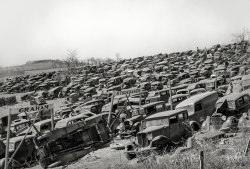
- Dry Goods: 1912
- Pittsburgh circa 1912. "Pennsylvania Avenue and Joseph Horne's store." 8x10 ... View Larger Map
(The Gallery, DPC, Pittsburgh, Stores & Markets, Streetcars) ... Posted by Dave - 08/11/2014 - 4:49am -
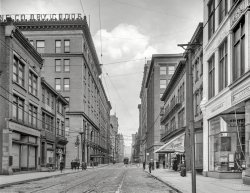
- A Really Big Shoe: 1905
- ...
Shoot the Shoe According to this article in the Pittsburgh Press of May 7, 1905, the "Shoot the Shoe" was new that spring. ... Posted by Dave - 08/13/2012 - 9:14pm -
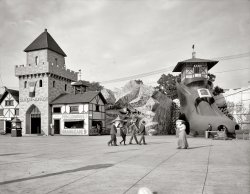
- Church Ladies: 1941
- January 1941. "Negro church in mill district of Pittsburgh, Pennsylvania." Acetate negative by Jack Delano for the Farm ... Church in the Hazelwood neighborhood southeast of downtown Pittsburgh. From what I can tell this church was originally located on Sylvan ... Posted by Dave - 12/30/2018 - 12:08pm -
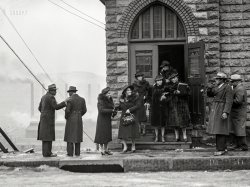
- Nats-Giants: 1924
- ... in 1925, he butchered the 1925 World Series against the Pittsburgh Pirates with some awful fielding. He committed a peck of errors.
... Posted by Dave - 09/11/2011 - 11:29am -
![Nats-Giants: 1924 October 10, 1924. Griffith Stadium in Washington, D.C. "Peckinpaugh sees final World Series game from dugout on account of injuries." View full size.
Isn't it the Senators?The old American League Washington Senators became the Twins and have nothing to do with the current Washington Nationals.
[The team was called the Nationals because Washington is the national capital. In 1924, hardly anyone called them the Senators. Below: Washington Post front page from the next day, October 11. - Dave]
The Big Train Finally WinsThis is the game that Walter Johnson, at age 36, pitches the final four shutout innings to nail down his and the Nationals' first (and last) World Series win.
The Big TrainHis house is still located out in Rockville which, in 1924, was far from downtown D.C. and just a small village. The NIH wasn't yet a dream, but would be just a mile away later. Contrast this photo with a modern dugout design! Makes Camden Yards look palatial!
Old MemoriesI had forgotten the Senators being called the Nationals until I saw this. I grew up in Baltimore, home of the Orioles, and the local sports reports often included the Senators results probably because the radio broadcast area reached Prince Georges County where many federal workers lived.
What a change the stadiums have seen in 80-odd years!
Johnson's motionI love the picture. I can smell the sweat and chewing tobacco wafting through the humid early October, D.C. air.
I was looking to see if Walter Johnson was visible. He threw a submarine side-arm pitch which caught people off guard because of the deceptive velocity. I believe that Ty Cobb took advantage of Johnson's fear of maiming a batter, and purposely crowded the plate after a full count. Ken Burn's "Baseball" has a nice segment about Johnson and provides rare footage of his pitching style.
Nats-Giants: 1924Having been a diehard and frustrated Washington Senators fan for most of my first 30 years, I find it oddly appropriate that their only World Championship was won in the seventh game on a bad-hop single in the bottom of the twelfth inning.
Click.Notice the Graflex Super D on the top step of the dugout.
Roger PRoger Peckinpaugh was well regarded in his day, frequently a captain of his ballclub. In fact, at age 23, he managed the New York Yankees for a brief spell.
However, the Nationals probably wished ol' Peck was in an overcoat 12 months after this picture was taken, and not playing shortstop.
Even though he was the American League's Most Valuable Player in 1925, he butchered the 1925 World Series against the Pittsburgh Pirates with some awful fielding. He committed a peck of errors.
Still and all, he spent a lifetime in the game and rose to executive officer with his hometown Cleveland Indians. He enjoyed an interesting career and lived until his 80's.
A hatted worldThis is hardly a new observation, but I can't help but be struck by the fact that every head one can make out in this photo is crowned. Nowhere does it seem to stand out more than in old photos of baseball stadium crowds - photos of people enjoying what most of us in today's world would consider an occasion that calls for very casual attire. What does this say about us, and about prior generations?
Walter JohnsonI actually have quite a few photos of Walter Johnson with my grandfather, who was a big fan. Shorpy, any interest?
Hanging in my foyer is a front page newspaper photo of him with Johnson, Goose Goslin and a few other players - he gave a free suit to any player who hit home runs (my grandfather owned a popular downtown men's clothing store).
For years I have been searching for a photo of Griffith stadium that included a view of my grandfather's ad that was hung in the stadium ... I have been through the LOC website and the MLK reading room with only one very poor result ... anyone have any other suggestions for me?
[It would help if we knew his name or the name of his store. - Dave]
Fred PelzmanFor Jennifer:
Click here (National Photo) or here (Harris & Ewing) and use the top box to search for "baseball." Then click the "Preview images" button to see the thumbnails.
There are dozens of articles and ads related to your grandfather in the Washington Post archive. Which you can probably search from your public library's website (look for "ProQuest Historical Newspapers") if you have a library card. Below are some examples from 1901, 1915, 1932 and 1948.
WJ continuedFred Pelzman's Fashion Shop ... I can send you images of some of the ads with his logo, if that would be helpful - Jennifer
Thank you!Hey Dave:
Thanks so much! I actually have collected a lot of the the materials from the WPost archives (via the library website, bless them for this resource!) - put together a scapbook for my father's 80th birthday last year. FYI, the top two ads here are from my great-grandfather's store (Schwartz & Pelzman) while the others are from my grandfather's - the latter was the big baseball fan. I will forward to you a few of the Walter Johnson photos in case any of your DC baseball fans might be interested.
Thanks so much for the recommendations, as a fourth-generation Washingtonian, this blog is such a huge treat!!!
Explaining "Nationals"The franchise officially changed its name from Senators to Nationals in 1905 because of a horrifically bad year in 1904. It was this name change that the new Nationals were referring to with the logos that say "Washington Nationals: Established 1905." I'm sure the fact that this name change occurred exactly 100 years before the Expos moved to D.C. inspired this.
Anyway, although the team was officially called the Nationals, many people still called them the "Senators" as an unofficial nickname. Since the team only had a "W" on their uniform, who could tell? It wasn't until Clark Griffith died and Calvin took over that the team officially became the Senators and began putting that team name on the front of their uniforms. It's because the team was called the "NATionalS" for so long that people still referred to the "SeNATorS" as "Nats." "Senators" fans in Harrisburg and Ottawa refer to their teams as the "Sens."
They don't look happy - - - yet.If the date is correct, this is the only day in history when a Washington team won the World Series -- despite the decidedly glum looks on virtually everyone in view. The game went 12 innings, and was won when the Giants committed two errors in the 12th. It was also the least-attended game in the series, with only 31,667 paid attendance, about 2,600 short of the previous game and over 35K for the first two games. Odd that there is no festive bunting in sight.
Roger Peckinpaugh was the shortstop for the Washington Nationals from 1922 through 1926, winning the MVP in 1925. He committed eight errors in the '25 Series, apparently still a major league record. His salary in 1924, by the way, was $10,000.
(The Gallery, D.C., Natl Photo, Sports)](https://www.shorpy.com/files/images/26164u.thumbnail.jpg)
- Bonus Army: 1932
- ... as today, was the focus of protest. Father James Cox of Pittsburgh already had led one jobless march on Washington, the Communist Party ... Posted by Dave - 07/31/2011 - 7:49pm -
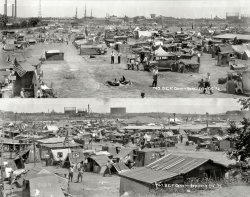
- Home, Work: 1938
- July 1938. "Slums near steel mill. Pittsburgh, Pennsylvania." Medium format acetate negative by Arthur Rothstein ... door No. 2
(The Gallery, Arthur Rothstein, Factories, Pittsburgh) ... Posted by Dave - 09/09/2020 - 10:59am -
![Home, Work: 1938 July 1938. "Slums near steel mill. Pittsburgh, Pennsylvania." Medium format acetate negative by Arthur Rothstein for the Farm Security Administration. View full size.
As we all can seeThe outhouse bottom right and the lack of indoor facilities. Upper right window with basin and the water and soap streak on the roof. Look out below. Mop on the roof is a nice touch.
[And yet, a vent stack running up to the roof. - Dave]
A lackingStrange that not a single smokestack is emitting the infamous heavy smoke known to be a signature of that region in those years.
Be it ever so humbleYou're never too fancy to have a broom on the roof.
DindowsDoors that are windows.
Zonk!I'll take whatever's behind door No. 2
(The Gallery, Arthur Rothstein, Factories, Pittsburgh)](https://www.shorpy.com/files/images/SHORPY-8b17105a.thumbnail.jpg)
- Schenley Park: 1910
- Pittsburgh circa 1910. "Schenley Park Bridge and the 'Tick' (Carnegie-Mellon ... the late sixties.
(The Gallery, Boats & Bridges, DPC, Pittsburgh, Railroads) ... Posted by Dave - 11/10/2018 - 9:56am -
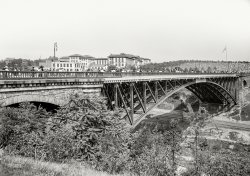
- Forbes Field: 1910
- Circa 1910. "Forbes Field, Pittsburgh." A continuation of this image . 8x10 inch dry plate glass ... View full size.
Childhood memory We lived in Pittsburgh in the late '50s to 1961 and my dad took me to one game around 1960. ...
(The Gallery, DPC, Pittsburgh, Sports) ... Posted by Dave - 11/10/2018 - 10:00am -
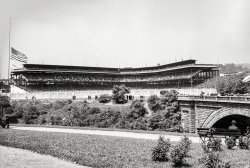
- Growth Spurt: 1912
- ... Along the Monongahela circa 1912. "A group of skyscrapers, Pittsburgh." 8x10 inch dry plate glass negative, Detroit Publishing Company. ... and later Captain W. J. Wood, Pacific No. 2 was built in Pittsburgh in 1893 using the steam engines from the former steam towboat ... Posted by Dave - 08/29/2017 - 7:16am -
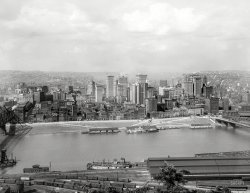
- Rear Window: 1938
- Pittsburgh slum dwelling, 1938. View full size. Photograph by Arthur ...
(The Gallery, Arthur Rothstein, Great Depression, Pittsburgh) ... Posted by Dave - 09/07/2011 - 7:58pm -
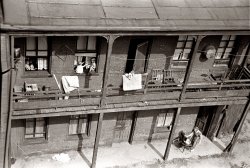
- Philadelphia Dental Rooms: 1904
- ... the Philadelphia Dental Rooms, on what seems to have been Pittsburgh's go-to street for Painless Dentistry. Looming over it all is the ... A couple blocks north is Wood Street Station, part of Pittsburgh's subway. Many visitors are surprised that Pittsburgh, like Paris ... Posted by Dave - 05/07/2018 - 2:32pm -
![Philadelphia Dental Rooms: 1904 1904. "Fifth Avenue, Pittsburg, Pa." Address of the Philadelphia Dental Rooms, on what seems to have been Pittsburgh's go-to street for Painless Dentistry. Looming over it all is the recently completed Farmers Bank building. View full size.
Farmers Bank focusWhy does the Farmers Bank building get more blurry the higher up you go?
[Use of the tilt-shift method to control parallel lines in tall buildings can bring the photographic plate into the edge range of the lens, where spherical aberration is most prominent. -tterrace]
Union Veteran LegionThe Union Veteran Legion, founded in 1884, was an organization of Union Civil War veterans who had "volunteered prior to July 1, 1863, for a term of 3 years, and were honorably discharged. Service in the military had to be of at least two years' duration if the discharge was due to wounds encountered on the battlefield."
Contrast that with the much larger Grand Army of the Republic, which did not have any restrictions for length of service.
There must have been some sort of friction between long-serving veterans and those who had served only a short time.
Note the dates - UVL was founded about 19 years after the end of the Civil War. This 1904 photo is 39 years after the end of the war, so the members are now in their sixties.
Old technologyI remember going with my father to his dentist when I was in kindergarten just to get out of my mom's hair. The dentist was an old man about ready to retire, so he had not updated his equipment in quite some time.
He had a foot operated drill which wasn't bad enough but he had arthritis in his knees, so the drill would slow down and speed up. I can only presume the drills were not as sharp as they should have been, compounding the pain.
This memory kept me away from the dentist for years. It was not until I got married in 1981 that I went to a dentist on the insistence of my new bride. He had a field day with my mouth. 14 cavities. 1 crown. 3 root canals. 1 pulled.
As the saying goes "Be true to your teeth otherwise they will be false to you."
A Most Interesting NeighborhoodI believe this is near the intersection of Fifth and Wood Street: an interesting neighborhood. Just a block south, at the corner of Forbes and Wood, stands "The Skinny Building," three stories wide, but only five feet wide. A couple blocks north is Wood Street Station, part of Pittsburgh's subway. Many visitors are surprised that Pittsburgh, like Paris and New York, has a subway.
An almost completely different world. What a difference a century or so can make. At least the Frick Building still stands:
(The Gallery, DPC, Pittsburgh)](https://www.shorpy.com/files/images/SHORPY-4a11820a.thumbnail.jpg)
- Wartime Rail: 1942
- September 1942. The Kroger warehouse in Pittsburgh, Pennsylvania. "Freight car movements. With transportation assuming ... the walker is inspecting?
(The Gallery, Ann Rosener, Pittsburgh, Railroads, WW2) ... Posted by Dave - 12/29/2017 - 12:06pm -
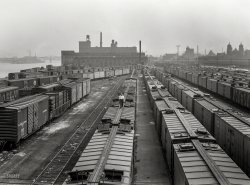
- Through to Morgantown: 1905
- Circa 1905. "Pittsburgh, Penna. -- the Monongahela wharves." 8x10 inch dry plate glass ... posh boat with top finishes and fittings, it catered to Pittsburgh's finer citizens. Her hinged stacks are laid down to run low ...
(The Gallery, Boats & Bridges, DPC, Pittsburgh, Railroads) ... Posted by Dave - 05/15/2017 - 3:33pm -
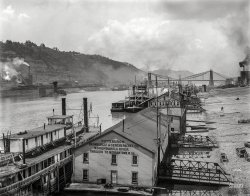
- Manhasset 346: 1942
- ... most interesting paintings are cityscapes of industrial Pittsburgh.
Kane's life story was told in "Sky Hooks: The Autobiography of ... Posted by Dave - 06/11/2021 - 3:52pm -
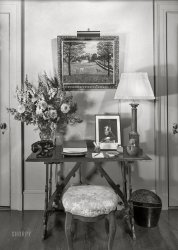
- Greyhound Garage: 1943
- September 1943. "Pittsburgh, Pennsylvania. Removing a tire from a bus at the Greyhound garage." ...
(The Gallery, Cars, Trucks, Buses, Esther Bubley, Pittsburgh) ... Posted by Dave - 09/02/2014 - 12:56pm -
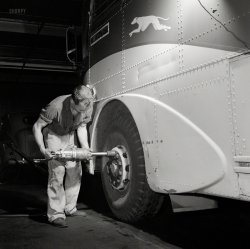
- R.R. Control Tower: 1940
- ... for the Baltimore & Ohio (ex-Buffalo, Rochester and Pittsburgh), with a roundhouse, engine repair shop capable of heavy overhauls, ... Posted by Dave - 11/18/2018 - 12:48pm -
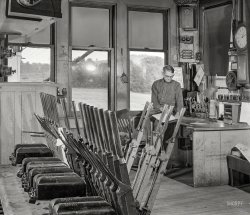
- Carnegie Steel: 1905
- ... gondola train cars, by hand, bound for the furnaces in Pittsburgh. Later he moved up to a job that my father said he would come home ... lid off That's how Dickens recorded his impression of Pittsburgh. This scene brought the phrase to mind.
Munnhall This is an ... Posted by Dave - 07/01/2014 - 2:47pm -
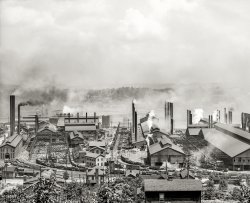
- Factory Town: 1910
- ... used to live up the hill I used to live up the hill in Pittsburgh, back when this steel mill produced one-third of the steel used in ... Posted by Dave - 07/29/2012 - 1:32pm -
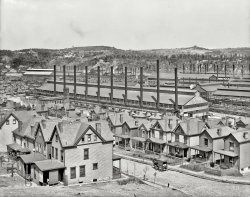
- Studebaker Cathedral: 1908
- ...
William A. Brady was the backer, and Herbert L. May of Pittsburgh sold the property to a syndicate headed by A.C. Quarrier. The new ... Posted by Dave - 08/09/2012 - 5:45am -
![Studebaker Cathedral: 1908 New York, 1908. "Old church on 48th Street." Studebaker Garage, a former Christian Science house of worship, at 143 West 48th Street. View full size. 8x10 glass negative, George Grantham Bain Collection, Library of Congress.
Studebaker CathedralAcross the street: The Marmon Tabernacle.
Hail, Taxi!And they said America worships the automobile. Well, this'll show'em.
Garage?Could someone explain why this building is called a garage?
[Because that's what it is. - Dave]
Garage noun A shelter or repair shop for automotive vehicles.
Garage? (Again)Doesn't anybody read the captions before sending questions?
[The giant STUDEBAKER GARAGE sign would also be a clue. - Dave]
Adaptive ReuseI found this photograph a bit shocking at first glance. The collision of the sacred and profane, if you will. I wonder if folks felt a bit put-off by it at the time? I can see the church name (or its ghost image) on the arch. Can someone tell us if this building still exists?
Studebaker GarageThe 1908 International Motor Cyclopaedia lists a Studebaker Garage at 48th and Broadway.
Netherland TheaterThis NY Times article from June 16, 1909, details plans to replace the church with a theater. The church was at 137-143 West 48th Street between Sixth and Seventh avenues, which is now the location of the 1221 Avenue of the Americas "Breezeway" and loading dock. Ironic that it's still kind of a garage.
William A. Brady was the backer, and Herbert L. May of Pittsburgh sold the property to a syndicate headed by A.C. Quarrier. The new theater was to be called The Netherland.
139 W 48th"From Abyssinian to Zion: A Guide to Manhattan's Houses of Worship" by David W. Dunlap lists the address of First Church of Christ, Scientist as 139 West 48th Street - the former All Souls Episcopal Church, a Romanesque-style church built in 1861. Just across the street from the Cort Theater today.
Ha!The Marmon Tabernacle! Good one, AT.
Denny Gill
Chugiak, Alaska
A two-way streetThe church my wife went to when she was growing up used to be a Studebaker dealership. Turnabout happens, I guess!
Good jobFantastic collection, well done.
BTW, I keep expecting to get to the full sized image by clicking on the smaller one...
Oh, that's another thing: the size of the pictures. 99% of pictures on the web are way too small. Kudos for bucking that trend.
Here at the Studebaker CathedralWe are the home of the first full-service drive-in church.
Our ushers will assist you upon entering.
Valve jobs are done in the in the organ loft while you wait.
Oil changes are done in the choir stalls. Use the east aisle upon entering.
Alignments and brake jobs are performed in the cloister.
Body repairs are done under the apse.
Tune-ups are done in the radiating chapels.
The Lady's Chapel is open during all business hours.
Our balcony contains thousands of repair parts for all makes and models.
Confessions heard while you wait. No charge.
Collections taken daily from 7:00 A.M. to 7:00 P.M.
"Drive in a wreck today!" (c)
Great pic!...RE: this siteThe Broadway theatre that replaced the site of the Studebaker/Cathedral was the Playhouse Theatre built in 1911 (info link below), which was torn down in 1969 to add to Rockefeller Center as an office building, after being used one last time for Mel Brooks' original film 'The Producers' for the Springtime for Hitler scenes...it was across the street from the Cort Theatre, which is still standing today & currently playing 'Breakfast at Tiffany's'...
http://www.ibdb.com/venue.php?id=1324
(The Gallery, Cars, Trucks, Buses, G.G. Bain, NYC)](https://www.shorpy.com/files/images/01403u1.thumbnail.jpg)
- River Coal: 1910
- ... at confluence of Allegheny and Monongahela rivers at Pittsburgh, Pennsylvania." 8x10 inch glass negative. View full size.
... River. She held the record time for round-trip between Pittsburgh and Cincinnati (4 days, 20 hours, 15 minutes), for which she earned ... Posted by Dave - 01/31/2014 - 9:35am -
